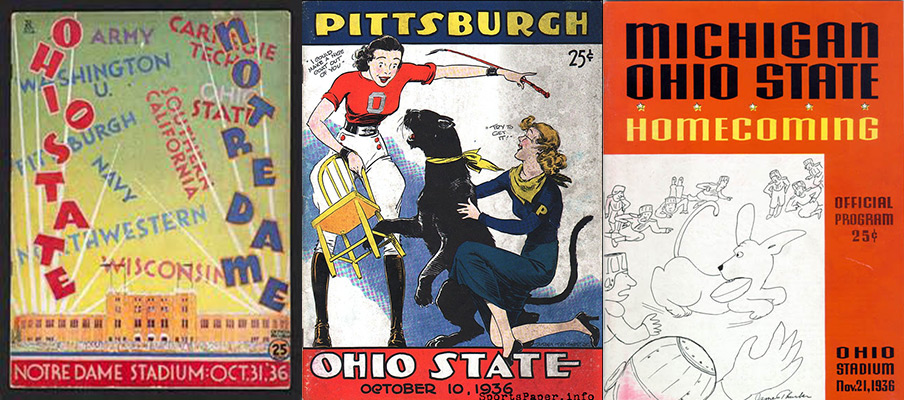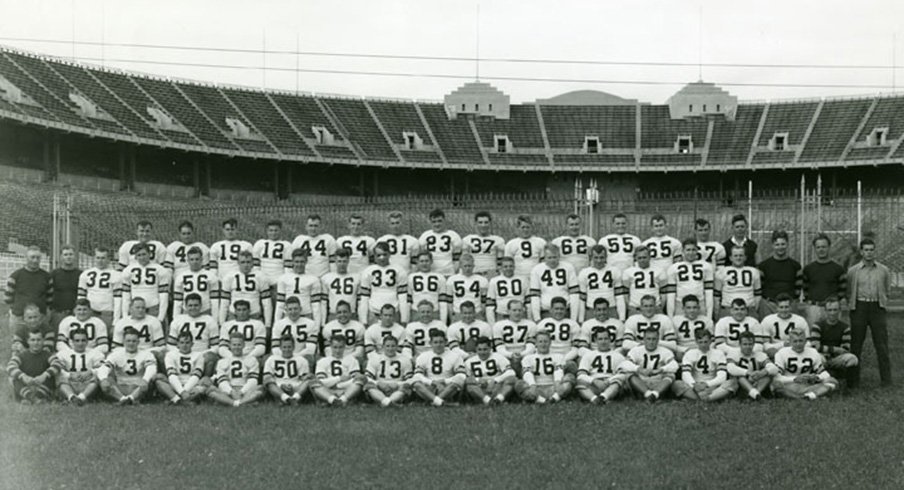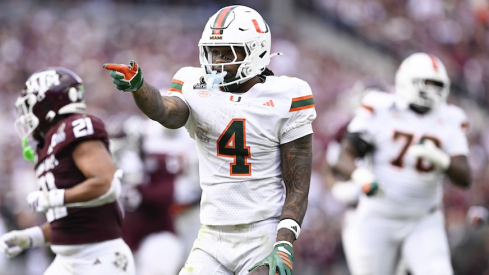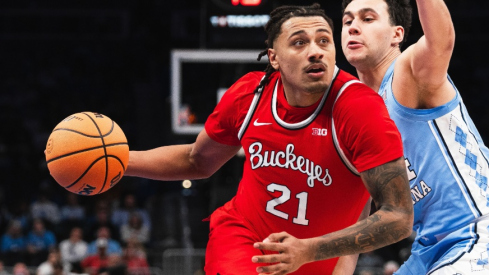Following back-to-back 7–1 seasons, 1936 was shaping up to be one for the ages for Francis Schmidt and his Buckeyes.
The success of Francis Schimdt's initial two seasons had fans and the media expecting more of the same, if not more. Schmidt had guided the Buckeyes to consecutive 7–1 records and just as importantly, was 2–0 against Michigan.
With a favorable schedule, a national championship was in sight for 1936. Unfortunately, the season would not go as planned.
| The 1936 Buckeyes | |
|---|---|
| Record | 5–3 |
| B1G Record | 4–1, 2nd |
| Coach | Francis Schmidt (3rd year, 19–5) |
| Captain | Merle Wendt |
Games of Note
October 3rd • New York University • Ohio Stadium
The opening game of the season pitted the Buckeyes against a new opponent, NY University. 72,948 fans filled the Shoe cheer the home team and set an opening day record.
On the first play of the game, the Violets threw a pass. That would be a mistake. Jim McDonald intercepted the ball and returned it 20 yards to put Ohio State up 7-0.
The first snap was a sign of things to come. The Buckeyes' defense finished the game with seven picks and kept NYU from scoring. Fittingly, Ohio State's final touchdown of the contest was a pick-six by Nick Wasylik.
When the final whistle blew, Ohio State etched a 60-0 laugher into the books.
| DATE | OPPONENT | LOCATION | RESULT |
|---|---|---|---|
| OCT. 3 | NY UNIVERSITY | OHIO STADIUM | W, 60–0 |
| OCT. 10 | PITTSBURGH | OHIO STADIUM | L, 0–6 |
| OCT. 17 | NORTHWESTERN | DYCHE STADIUM | L, 13–14 |
| OCT. 24 | INDIANA | OHIO STADIUM | W, 7–0 |
| OCT. 31 | NOTRE DAME | NOTRE DAME STADIUM | L, 2–7 |
| NOV. 7 | CHICAGO | OHIO STADIUM | W, 44–0 |
| NOV. 14 | ILLINOIS | MEMORIAL STADIUM | W, 13–0 |
| NOV. 21 | MICHIGAN | OHIO STADIUM | W, 21–0 |
| 5–3, 160–27 |
October 10th • Pittsburgh • Ohio Stadium
It's hard to believe, but Pittsburgh entered this game as the favored team. The Panthers possessed a powerful running game and had only suffered three losses in its last 30 games.
Fans expecting another high-scoring affair did not get their wish. Through three quarters, the game remained scoreless. In the late stages of the fourth quarter, Pittsburgh made its move.
From the Columbus Dispatch:
Running the famous Red Grange letter S play, (Harold) Stebbins skirted Ohio's right end for 35 yards to cross the goal line standing up. The play was executed flawlessly. It is not a new maneuver and is in the notebook of all coaches, who credit Bob Zuppke of Illinois with devising it to break Red Grange into the open.
The Panthers took notes from the NYU game and never gave Ohio State's defense a chance to make an interception. Jock Sutherland, Pittsburgh's head coach, kept the pedal down on run for the entire game as his Panthers went 60 minutes without attempting a pass. The strategy worked and Pitt won, 6-0.
Sutherland never faced Ohio State again. He finished his career with a 2–1–1 record against the Buckeyes.
Of note, the incomparable Script Ohio was performed by the Ohio State University Marching Band for the first time during halftime of this game.
| OPPONENT | STREAK | RECORD |
|---|---|---|
| NYU | W1 | 1–0 |
| PITTSBURGH | L1 | 1–2–1 |
| NORTHWESTERN | L1 | 10–5 |
| INDIANA | W4 | 12–6–3 |
| NOTRE DAME | L2 | 0–2 |
| CHICAGO | W5 | 7–2–2 |
| ILLINOIS | W2 | 11–12–2 |
| MICHIGAN | W3 | 9–22–2 |
October 17th • Northwestern • Dyche Stadium
Ohio State would travel to Evanston, Ill. to face Northwestern in the week following the loss to Pittsburgh. Schmidt's team was vying for its fifth-straight win against the Wildcats, but Northwestern had other plans.
Six turnovers and a missed extra point were the downfall for Ohio State, as the Buckeyes fell at Dyche Stadium – now Ryan Field – by a score of 14-13.
Ohio State had lost consecutive games for the first time in six years. Suddenly 1–2, this was not the season Schmidt, or the fans, anticipated.
October 31st • Notre Dame • Notre Stadium
The Buckeyes returned home for a 7-0 win over Indiana to set up a revenge game against Notre Dame in week five. Schmidt – and fans – were sure the team would be properly motivated one year after collapsing at home against the Irish.
50,017 fans packed into Notre Dame Stadium – a record for the Irish at the time – for a heated contest.
A heavy rain that persisted throughout the game kept the scoring low, but the drama high. Ohio State trailed 7-2 late in the fourth quarter, but was on the Notre Dame 12 yard line and threatening to score.
On first down, Nick Wasylik targeted Joe Williams in the end zone. Wasylik's toss was off and the ball fell harmlessly to the ground.
Wasylik again dropped back to pass on second down. Again, he missed his target and the ball landed in the end zone. At least that's what the refs ruled. The Buckeye players adamantly argued the ball hit the ground short of the goal line. To add to the confusion the sun was setting in South Bend and the stadium was dark. Ohio State's arguments fell on deaf ears. In the end the refs stayed with their ruling that the second pass also landed in the end zone.
Why did it matter where the ball landed? In today's game Ohio State would have faced third and 10 from the 12 yard line. However, this was 1936. The rules stated if a team had consecutive incomplete passes land in the end zone the result would be a touchback and the defending team would gain possession of the ball.
And you wonder why Woody Hayes grew up hating the forward pass.
Ohio State left South Bend with a 2–3 record on the season and would have to wait for that revenge against Notre Dame for 59 long years.
November 14th • Illinois • Memorial Stadium
The week after losing to Notre Dame, the Buckeyes headed back to the friendly confines of Ohio Stadium to play Chicago. Frustrations were indeed taken out and the Maroons limped out of the Shoe following a 44-0 beating.
Next up: Illinois.
Dating to the birth of the Illibuck tradition in 1924, Ohio State and Illinois were deadlocked at 6–6 for control of the now wooden turtle.
The game went to the half a scoreless affair, but Johnny Rabb put his Buckeyes up 7-0 with a 30-yard touchdown run in the third quarter. He would finish the game with 144 yards and Ohio State won 13-0, giving the Bucks a one-game edge for control of Illibuck.
November 21st • Michigan • Ohio Stadium
Ohio State entered “The Game” with a little extra incentive. It was homecoming, the program's 400th football game and the team had a chance to prevent Michigan from winning a game in the Big Ten.
The Buckeyes had a disappointing 4–3 record, but were playing for their third straight win over Michigan. It was a task made easier against a Michigan team that was 1–6 and had been outscored 106-36 on the year. Michigan's coach, Harry Kipke was struggling. Since 1934, his team had a 6–18 overall record, was just 2–14 in Big Ten play and had lost three-straight to the Buckeyes.
After a scoreless first quarter, the 56,202 in attendance might have felt nervous. Tippy Dye put the nerves to rest when he connected with Frank Cumiskey for a 14-yard touchdown pass. Later, Dye lateraled to Rabb for a 31-yard touchdown run.
With Ohio State leading 14-0, Wasylik put the Wolverines on ice with his 10-yard score. The 21-0 victory made Schmidt the first Ohio State coach to start his career 3–0 against Michigan.
Gold pants all around.
With the win, Ohio State improved to 9–22–2 against their rival.

1936 Recap
- Ohio State played NY University for the first time.
- During halftime of the Pittsburgh game, Script Ohio was performed for the first time.
- The Buckeyes played at Notre Dame Stadium for the first time.
- Ohio State took a 7–6 series advantage in games played for the Illibuck trophy.
- Francis Schmidt improved to 3–0 against Michigan.
- Charlie Hamrick, Merle Wendt and Inwood Smith were named All-Americans. Wendt became third Buckeye to be named an All-American three times.
The 1936 Buckeyes played better than their 5–3 record. The team outscored its opponents 160-27 and shut out five of their eight opponents, allowing only four touchdowns on the season.
Still, the season was a let down for Schmidt and his team.



